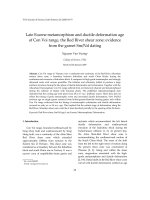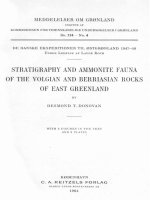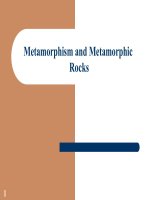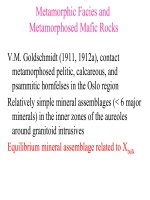Metamorphism and Metamorphic Rocks
Bạn đang xem bản rút gọn của tài liệu. Xem và tải ngay bản đầy đủ của tài liệu tại đây (2.27 MB, 52 trang )
1
Metamorphism and Metamorphic
Rocks
2
What is Metamorphism? (1)
Metamorphism is the change in form that
happens in Earth’s crustal rocks in response to
changes in temperature and pressure.
3
What is Metamorphism? (2)
There are six major factors that control
metamorphism:
Chemical composition
Temperature change
Pressure change
Fluids: present or absent
Time: how long a rock is subjected to high pressure or
high temperature.
Deformation type: whether the rock is simply compressed
or is twisted and broken during metamorphism.
4
Chemical Composition of Original
Rock
The most important: chemical composition of the
original rock (parent rock) – it controls the
mineralogy of the metamorphosed rock.
5
Temperature And Pressure (1)
Rock can be heated by burial or by nearby
igneous intrusion.
Burial is accompanied by an increase in pressure
due to the weight of the overlying rocks.
An intrusion may be shallow, resulting in low
pressure, or deep, resulting in high pressure.
6
Fig: heat sources vs. local & regional
thermal metamorphism
7
Temperature And Pressure (2)
Low-grade metamorphism: at low temperatures
c.a. 100oC to 500oC, and at relatively low
pressures.
High-grade metamorphism: at high
temperatures (above 500oC), and at high
pressure.
Figure 8.1
9
Stress
Stress is applied pressure that results in
deformation in a solid, and the development of
new textures.
Uniform stress occurs if pressure is equal in all
directions.
Differential stress occurs if pressure is different
in different directions.
Texture is controlled by differential versus
uniform stress.
Figure 8.2
11
Figure 8.2A: Result of uniform stress
Figure 8.2B: Result of differential stress
Figure 8.3
Result of differential stress: extension resulting in boudinage
(boudins are lenticular parts of sandstone/quartzite beds
dismembered by “sub-horizontal” extension/stretching) & max
stress/pressure: “sub-vertical”: schistosity of mudstone
15
Fluids and Metamorphism (1)
Sedimentary rocks have open spaces between their grains
filled by a watery intergranular fluid.
This fluid:
Is never pure water.
Always contains small amounts of dissolved gases and salts.
Contains traces of all the mineral constituents present in the
enclosing rocks.
Is an important transporting medium for ions.
16
Fluids and Metamorphism (4)
When intergranular fluids are absent,
metamorphic reactions are very slow.
When pressure increases due to burial of a rock,
and as metamorphism proceeds, the amount of
pore space decreases and the intergranular fluid
is slowly squeezed from the rock.
17
Fluids and Metamorphism (5)
Any fluid that escapes during metamorphism
will carry with it small amounts of dissolved
mineral matter.
Minerals precipitated in a facture are called a vein.
Metamorphic changes that occur while
temperatures and pressures are rising (usu. In
presence of intergranular fluid) are termed
prograde metamorphic effects (prograde
metamorphism) .
Figure B8.2
Prograde & retrograde metam
19
Fluids and Metamorphism (6)
Metamorphic changes that occur as temperature
and pressure are declining (and usually after
much of the intergranular fluid has been
expelled) are called retrograde metamorphic
effects (retrograde metamorphism) .
20
Role of Time in Metamorphism
Coarse-grained rocks are the products of long
sustained metamorphic conditions (possibly over
millions of years) at high temperatures and
pressures.
Fine-grained rocks are products of lower
temperatures, lower pressures or, in some cases,
short reaction times.
21
The Upper And Lower Limits Of
Metamorphism
At the lower end, metamorphism occurs in
sedimentary and igneous rocks that are
subjected to temperatures greater than about
100oC, usually under pressures of hundreds of
atmospheres, caused by the weight of a few
thousand meters of overlying rock.
At the upper end, metamorphism ceases to occur
at temperatures that melt rock.
22
How Rocks Respond To Temperature
and Pressure Change In Metamorphism
Lower-grade Metamorphism: Slaty Cleavage.
the newly forming sheet-structure minerals create
foliation that tends to be parallel to the bedding
planes of the sedimentary rock being metamorphosed.
Higher-grade Metamorphism: Schistosity.
At intermediate and high grades of metamorphism,
grain size increases.
Foliation in coarse-grained metamorphic rocks is
called schistosity (the parallel arrangement of coarse
grains of the sheet-structure minerals).
Figure 8.5
Figure 8.6
25









